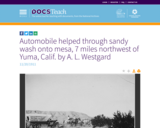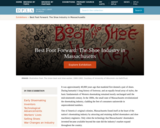
This is an activity that involves analyzing a map of the Louisiana Purchase. Guiding questions are offered.
- Subject:
- Social Science
- Material Type:
- Primary Source
- Provider:
- National Archives
- Date Added:
- 07/22/2024

This is an activity that involves analyzing a map of the Louisiana Purchase. Guiding questions are offered.

The purpose of this Roadmap is work on the Science and Engineering Practices—specifically engaging in argument from evidence and obtaining, evaluating, and communicating information. During this roadmap students will synthesize information from several articles about plastics and the environment and the role regulation plays in our communities. At the end of their research students are expected to write an opinion essay answering the question: Should we ban plastics?.
This opinion piece is also an opportunity for students to practice writing in Claim-Evidence-Reasoning. As an extension, students can then engage in a debate but this is optional based on time constraints and how ‘in depth’ you want this to be for your students.
Overall expect this to take several days 2 for research and synthesis, 1 to write their papers, and then additional time for debate.

The following artifact analysis worksheet was designed and developed by the Education Staff of the National Archives and Records Administration. You may find this worksheet useful as you introduce students to artifacts and primary sources of material culture, society and history.

In this activity, students examine photographs from an Alaskan Native Tribe who converted to the Anglican faith; they look for evidence of cultural assimilation and provide an opinion as to whether or not this type of cultural assimilation is beneficial or harmful to the tribe.

Prerequisite: Students need to have studied the Dawes Act of 1887 and the breaking up of reservations. In this activity, students analyze primary resources to determine how the federal government tried to assimilate Native Americans. Online activity. Focus: Compare and contrast.

This collection uses primary sources to explore the Atomic Bomb and the Nuclear Age it started. Digital Public Library of America Primary Source Sets are designed to help students develop their critical thinking skills and draw diverse material from libraries, archives, and museums across the United States. Each set includes an overview, ten to fifteen primary sources, links to related resources, and a teaching guide. These sets were created and reviewed by the teachers on the DPLA's Education Advisory Committee.

Photo taken 11/20/1911

In this 1949 photo from the National Archives an automobile is shown with a man on horseback.

Students analyze two letters written by FDR in order to determine the significance that baseball played during WW1 and WW2 in uplifting morale.

Baseball has been part of the culture of the United States since the earliest days of the nation, and the ways in which the game has changed through the centuries provide opportunities to explore changes in U.S. society. This primary source set includes documents and images. A teacher guide is included to assist educators in utilizing the primary sources in their instruction.

The American Red Cross (officially named The American National Red Cross) was founded in 1881 by Clara Barton, an American humanitarian and civil rights activist. Barton modeled the American Red Cross (ARC) after the International Red Cross, based in Geneva, Switzerland, which she encountered while volunteering in Europe during the late 1800s. She envisioned an organization that would provide humanitarian aid during wartime and in the event of national calamities.

Presented by Digital Public Library of America, this collection uses primary sources to explore Toni Morrison's Beloved. Digital Public Library of America Primary Source Sets are designed to help students develop their critical thinking skills and draw diverse material from libraries, archives, and museums across the United States. Each set includes an overview, ten to fifteen primary sources, links to related resources, and a teaching guide. These sets were created and reviewed by the teachers on the DPLA's Education Advisory Committee.

This collection uses primary sources to explore Toni Morrison's Beloved. Digital Public Library of America Primary Source Sets are designed to help students develop their critical thinking skills and draw diverse material from libraries, archives, and museums across the United States. Each set includes an overview, ten to fifteen primary sources, links to related resources, and a teaching guide. These sets were created and reviewed by the teachers on the DPLA's Education Advisory Committee.

It was approximately 40,000 years ago that mankind first donned a pair of shoes. During humanitys long history of footwear, and an equally broad array of styles, the basic fundamentals of Western shoemaking remained mostly unchanged until the mid-nineteenth century. In the 1800s, the small state of Massachusetts revolutionized the shoemaking industry, cladding the feet of consumers nationwide in unprecedented numbers. One of Americas original colonies, Massachusetts found itself at the heart of the nations shoemaking industry by attracting and retaining skilled shoemakers and shoe machinery engineers. Only when the technology that Massachusetts' shoemakers invented became available beyond the state did the industrys market expand throughout the country. Even with the spread of industrialization, Massachusetts remained the largest producer of shoes in the United States through World War I, responsible for nearly forty percent of Americas shoes and home to an equal percentage of its shoemakers. This exhibition was created as part of the DPLAs Public Library Partnerships Project by collaborators from Digital Commonwealth. Exhibition organizer: Anna Fahey-Flynn.

In this activity students will identify and define seven key ideas contained in the U.S. Constitution by making matches from the grid. They will then analyze documents that demonstrate each big idea in action.
This activity is designed to prepare students for the Constitution-in-Action Learning Lab at the National Archives in Washington, DC. It is a part of a package of pre-visit activities associated with the lab experience.

The Constitution might never have been ratified if the framers hadn't promised to add a Bill of Rights. The first ten amendments to the Constitution gave citizens more confidence in the new government and contain many of today's Americans' most valued freedoms.

On September 25, 1789, the First Congress of the United States proposed to the state legislatures 12 amendments to the Constitution that met the arguments most frequently advanced against it. The first two proposed amendments, which concerned the number of constituents for each representative and the compensation of congressmen, were not ratified. Articles 3 to 12, however, were ratified by three-fourths of the state legislatures and constitute the first ten amendments of the Constitution, known as the Bill of Rights.

The first 10 amendments to the Constitution make up the Bill of Rights. James Madison wrote the amendments, which list specific prohibitions on governmental power, in response to calls from several states for greater constitutional protection for individual liberties. For example, the Founders saw the ability to speak and worship freely as a natural right protected by the First Amendment. Congress is prohibited from making laws establishing religion or abridging freedom of speech. The Fourth Amendment safeguards citizensâ" right to be free from unreasonable government intrusion in their homes through the requirement of a warrant.

This collection uses primary sources to explore the Black Power Movement. Digital Public Library of America Primary Source Sets are designed to help students develop their critical thinking skills and draw diverse material from libraries, archives, and museums across the United States. Each set includes an overview, ten to fifteen primary sources, links to related resources, and a teaching guide. These sets were created and reviewed by the teachers on the DPLA's Education Advisory Committee.

In 1803, the United States purchased the Louisiana Territory800,000 square miles of land in the interior of North America. Most of this land had not been previously explored or documented. President Thomas Jefferson chose Meriwether Lewis and William Clark to lead an ambitious military expedition, seeking a northwestern passage to the Pacific Ocean and to document their journey in this unknown territory. Starting in what is now Missouri, the expedition followed the Missouri River and passed through present-day Montana on its way to the Pacific. The explorers commented on the beauty of the landscape and the abundance of animals, and their descriptions attracted fur traders and others ready to take advantage of the region's abundant natural resources. The discovery of gold in 1862 brought in the first rush of people and subsequent mining forever changed the region. The mining industry demanded support in the form of towns, railroads, logging, ranching, and farming. These industries shaped Montana and the people who settled there. This exhibition explores the industries that brought settlers to Montana from the early days to the 1920s. Each industry had its own boom and bust cycle that impacted the residents and the future of the state. This exhibition was created as part of the DPLAs Public Library Partnerships Project by collaborators from Montana Memory Project: Jennifer Birnel, Della Yeager, Cody Allen, Dale Alger, Caroline Campbell, Carly Delsigne, Pam Henley, Stef Johnson, Lisa Mecklenberg-Jackson, Laura Tretter, and Franky Abbott. Exhibition organizers: Jennifer Birnel and Franky Abbott.